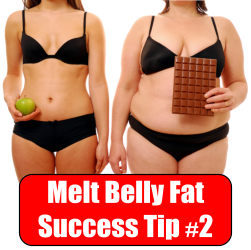When people think belly fat, they usually think of possible natural components like fat and carbohydrates. But did you know that proteins can actually affect how much belly fat you carry?
Actually, it is not necessarily the protein itself, but the lack of protein in your diet which can cause you to gain and retain high levels of fat in and around your stomach. Let’s take a look at exactly how proteins affect belly fat, and what you can do with this information to ensure that you do not sport a spare tire around your midsection.
Reduce Belly Fat with Protein in the Morning
Many people in today’s busy world take little or no time to eat breakfast. The problem here is this means no protein is there to start your day. When your body does not get enough protein in the a.m., you suffer those mid-morning snack attacks.
And what do people eat for a snack a couple of hours before lunch when they are feeling run down and tired? Unfortunately, high-calorie, high-sugar and high-fat treats with little nutritional value are often chosen. These are the types of foods that literally go straight your waistline, creating unwanted and unhealthy belly fat.
This is why you are more likely to pack on the pounds if you skip breakfast. You have not had anything to eat since the night before, and your body begins storing calories instead of burning them, since it doesn’t know when the next meal is going to be coming.
Eating Enough Protein Helps Reduce Belly Fat
Fortunately, you can use protein’s relationship with body fat to your advantage. Sufficient protein levels in your body keep insulin levels low. Insulin stores sugar as fat, so plenty of protein in your diet actually helps reduce belly fat.
To keep the proper hormonal balance working to your advantage, bump up your protein levels. Multiple studies show that approximately 20 to 25 g of protein per meal, and 10 to 15 g per snack, are reasonable levels of protein to include in your diet. This will keep your blood sugar balanced and insulin low, which is a perfect metabolic formula for appetite control and belly fat loss.
Protein also boosts many of your fat-burning and appetite-quenching hormones when consumed in the right amounts.
A Simple Formula: Protein Up – Belly Fat Down
Diabetes Care conducted an important study about the protein relationship with belly fat. 54 obese women and men with type II Diabetes were given either a high-protein or low-protein diet. Belly fat and total body fat were both reduced in much greater quantities in the test subjects eating a high-protein diet.
The Best “Belly Fat Down” Choices
What types of proteins should you focus on for the best belly fat busting performance? Stick to lean chicken and turkey, and low-fat cheeses such as ricotta and cottage cheese. Get Omega-3 and protein-rich eggs and fish in your diet, and your body’s protein levels will be affecting your belly fat in the most positive manner.
You can find more “Belly Fat Success Tips” in our weight loss category found at http://myfitnessnut.com and while you’re they, be sure to subscribe to our monthly fitness newsletter and be kept up to date on the latest developments in the world of health and fitness.









